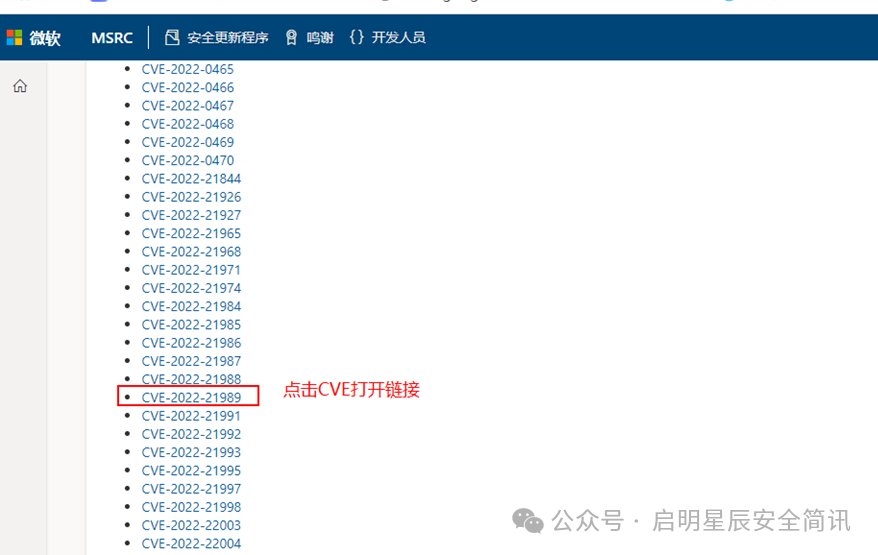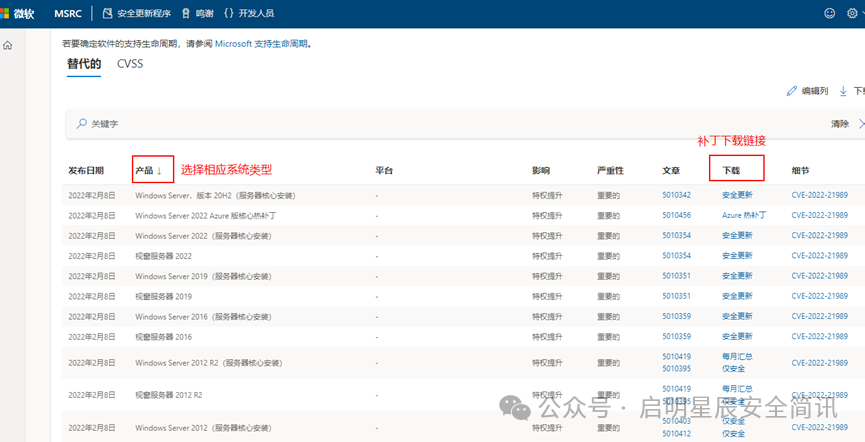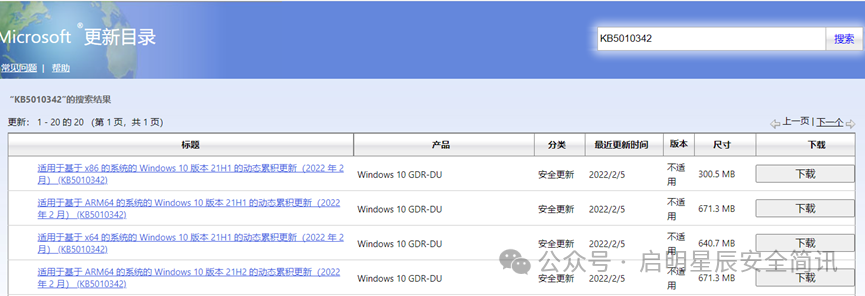【漏洞通告】微软10月多个安全漏洞
发布时间 2025-10-15一、漏洞概述
2025年10月15日,启明星辰集团VSRC监测到微软发布了10月安全更新,本次更新修复了174个漏洞,涵盖特权提升、远程代码执行、信息泄露等多种漏洞类型。漏洞级别分布如下:15个严重级别漏洞,157个重要级别漏洞,2个中危级别漏洞(漏洞级别依据微软官方数据)。
其中,16个漏洞被微软标记为“更可能被利用”及“检测利用情形”,表明这些漏洞存在较高的利用风险,建议优先修复以降低潜在安全威胁。
CVE-ID | CVE 标题 | 漏洞级别 |
CVE-2025-48004 | Microsoft 代理文件系统特权提升漏洞 | 重要 |
CVE-2025-24052 | Windows Agere 调制解调器驱动程序特权提升漏洞 | 重要 |
CVE-2025-55676 | Windows USB 视频类系统驱动程序信息披露漏洞 | 重要 |
CVE-2025-55680 | Windows Cloud Files Mini Filter Driver 特权提升漏洞 | 重要 |
CVE-2025-55681 | 桌面窗口管理器特权提升漏洞 | 重要 |
CVE-2025-55692 | Windows 错误报告服务特权漏洞提升 | 重要 |
CVE-2025-55693 | Windows 内核特权提升漏洞 | 重要 |
CVE-2025-55694 | Windows 错误报告服务特权漏洞提升 | 重要 |
CVE-2025-58722 | Microsoft DWM 核心库权限提升漏洞 | 重要 |
CVE-2025-59194 | Windows 内核特权提升漏洞 | 重要 |
CVE-2025-59199 | 软件保护平台(SPP) 特权提升漏洞 | 重要 |
CVE-2025-59246 | Azure Entra ID 特权提升漏洞 | 严重 |
CVE-2025-59287 | Windows 服务器更新服务 (WSUS) 远程代码执行漏洞 | 严重 |
CVE-2025-59502 | Remote Procedure Call Denial of Service Vulnerability | 中 |
CVE-2025-24990 | Windows Agere 调制解调器驱动程序特权提升漏洞 | 重要 |
CVE-2025-59230 | Windows 远程访问连接管理器特权提升漏洞 | 重要 |
微软10月更新修复的完整漏洞列表如下:
CVE-ID | CVE 标题 | 漏洞级别 |
CVE-2025-24052 | Windows Agere 调制解调器驱动程序特权提升漏洞 | 重要 |
CVE-2025-24990 | Windows Agere 调制解调器驱动程序特权提升漏洞 | 重要 |
CVE-2025-25004 | PowerShell 权限提升漏洞 | 重要 |
CVE-2025-47979 | Microsoft 故障转移群集信息泄漏漏洞 | 重要 |
CVE-2025-47989 | Azure Connected Machine Agent 特权提升漏洞 | 重要 |
CVE-2025-48004 | Microsoft 代理文件系统特权提升漏洞 | 重要 |
CVE-2025-48813 | Virtual Secure Mode Spoofing Vulnerability | 重要 |
CVE-2025-49708 | Microsoft 图形组件特权提升漏洞 | 严重 |
CVE-2025-50152 | Windows 内核特权提升漏洞 | 重要 |
CVE-2025-50174 | Windows 设备关联中转站服务特权提升漏洞 | 重要 |
CVE-2025-50175 | Windows 数字媒体特权提升漏洞 | 重要 |
CVE-2025-53139 | Windows Hello 安全功能绕过漏洞 | 重要 |
CVE-2025-53717 | Windows 基于虚拟化的安全性 (VBS) Enclave 特权提升漏洞 | 重要 |
CVE-2025-53768 | Xbox IStorageService 特权提升漏洞 | 重要 |
CVE-2025-53782 | Microsoft Exchange Server 特权提升漏洞 | 重要 |
CVE-2025-55240 | Visual Studio 特权提升漏洞 | 重要 |
CVE-2025-55247 | .NET 特权提升漏洞 | 重要 |
CVE-2025-55248 | .NET、.NET Framework 和 Visual Studio 信息泄露漏洞 | 重要 |
CVE-2025-55315 | ASP.NET 安全功能绕过漏洞 | 重要 |
CVE-2025-55320 | 配置管理器特权提升漏洞 | 重要 |
CVE-2025-55321 | Azure Monitor 日志分析欺骗漏洞 | 严重 |
CVE-2025-55325 | Windows 存储管理提供程序信息披露漏洞 | 重要 |
CVE-2025-55326 | Windows 互联设备平台服务 (Cdpsvc) 远程代码执行漏洞 | 重要 |
CVE-2025-55328 | Windows Hyper-V 特权提升漏洞 | 重要 |
CVE-2025-55330 | Windows BitLocker 安全功能绕过漏洞 | 重要 |
CVE-2025-55331 | Windows PrintWorkflowUserSvc 特权提升漏洞 | 重要 |
CVE-2025-55332 | Windows BitLocker 安全功能绕过漏洞 | 重要 |
CVE-2025-55333 | Windows BitLocker 安全功能绕过漏洞 | 重要 |
CVE-2025-55334 | Windows 内核安全功能绕过漏洞 | 重要 |
CVE-2025-55335 | Windows NTFS 特权提升漏洞 | 重要 |
CVE-2025-55336 | Windows Cloud Files Mini Filter Driver 信息泄露漏洞 | 重要 |
CVE-2025-55337 | Windows BitLocker 安全功能绕过漏洞 | 重要 |
CVE-2025-55338 | Windows BitLocker 安全功能绕过漏洞 | 重要 |
CVE-2025-55339 | Windows 网络驱动程序接口规范驱动程序特权提升漏洞 | 重要 |
CVE-2025-55340 | Windows 远程桌面协议安全功能绕过 | 重要 |
CVE-2025-55676 | Windows USB 视频类系统驱动程序信息披露漏洞 | 重要 |
CVE-2025-55677 | Windows 设备关联中转站服务特权提升漏洞 | 重要 |
CVE-2025-55678 | DirectX 图形内核特权提升漏洞 | 重要 |
CVE-2025-55679 | Windows 内核信息泄露漏洞 | 重要 |
CVE-2025-55680 | Windows Cloud Files Mini Filter Driver 特权提升漏洞 | 重要 |
CVE-2025-55681 | 桌面窗口管理器特权提升漏洞 | 重要 |
CVE-2025-55682 | Windows BitLocker 安全功能绕过漏洞 | 重要 |
CVE-2025-55683 | Windows 内核信息泄露漏洞 | 重要 |
CVE-2025-55684 | Windows PrintWorkflowUserSvc 特权提升漏洞 | 重要 |
CVE-2025-55685 | Windows PrintWorkflowUserSvc 特权提升漏洞 | 重要 |
CVE-2025-55686 | Windows PrintWorkflowUserSvc 特权提升漏洞 | 重要 |
CVE-2025-55687 | Windows Resilient 文件系统 (ReFS) 特权提升漏洞 | 重要 |
CVE-2025-55688 | Windows PrintWorkflowUserSvc 特权提升漏洞 | 重要 |
CVE-2025-55689 | Windows PrintWorkflowUserSvc 特权提升漏洞 | 重要 |
CVE-2025-55690 | Windows PrintWorkflowUserSvc 特权提升漏洞 | 重要 |
CVE-2025-55691 | Windows PrintWorkflowUserSvc 特权提升漏洞 | 重要 |
CVE-2025-55692 | Windows 错误报告服务特权漏洞提升 | 重要 |
CVE-2025-55693 | Windows 内核特权提升漏洞 | 重要 |
CVE-2025-55694 | Windows 错误报告服务特权漏洞提升 | 重要 |
CVE-2025-55695 | Windows WLAN AutoConfig 服务信息泄露漏洞 | 重要 |
CVE-2025-55696 | NtQueryInformation Token 函数 (ntifs.h) 特权提升漏洞 | 重要 |
CVE-2025-55697 | Azure Local 特权提升漏洞 | 重要 |
CVE-2025-55698 | DirectX 图形内核拒绝服务漏洞 | 重要 |
CVE-2025-55699 | Windows 内核信息泄露漏洞 | 重要 |
CVE-2025-55700 | Windows 路由和远程访问服务 (RRAS) 信息披露漏洞 | 重要 |
CVE-2025-55701 | Windows 身份验证特权提升漏洞 | 重要 |
CVE-2025-58714 | WinSock 的 Windows 辅助功能驱动程序特权提升漏洞 | 重要 |
CVE-2025-58715 | Windows 语音运行时特权提升漏洞 | 重要 |
CVE-2025-58716 | Windows 语音运行时特权提升漏洞 | 重要 |
CVE-2025-58717 | Windows 路由和远程访问服务 (RRAS) 信息披露漏洞 | 重要 |
CVE-2025-58718 | 远程桌面客户端远程执行代码漏洞 | 重要 |
CVE-2025-58719 | Windows 互联设备平台服务特权提升漏洞 | 重要 |
CVE-2025-58720 | Windows 加密服务信息泄露漏洞 | 重要 |
CVE-2025-58722 | Microsoft DWM 核心库权限提升漏洞 | 重要 |
CVE-2025-58724 | 已启用Arc 的服务器 - Azure Connected Machine Agent 特权提升漏洞 | 重要 |
CVE-2025-58725 | Windows COM+ 事件系统服务特权提升漏洞 | 重要 |
CVE-2025-58726 | Windows SMB Server Elevation of Privilege Vulnerability | 重要 |
CVE-2025-58727 | Windows 互联设备平台服务特权提升漏洞 | 重要 |
CVE-2025-58728 | Windows Bluetooth 服务特权提升漏洞 | 重要 |
CVE-2025-58729 | Windows 本地会议管理器 (LSM) 拒绝服务漏洞 | 重要 |
CVE-2025-58730 | 收件箱COM 对象(全局内存)远程代码执行漏洞 | 重要 |
CVE-2025-58731 | 收件箱COM 对象(全局内存)远程代码执行漏洞 | 重要 |
CVE-2025-58732 | 收件箱COM 对象(全局内存)远程代码执行漏洞 | 重要 |
CVE-2025-58733 | 收件箱COM 对象(全局内存)远程代码执行漏洞 | 重要 |
CVE-2025-58734 | 收件箱COM 对象(全局内存)远程代码执行漏洞 | 重要 |
CVE-2025-58735 | 收件箱COM 对象(全局内存)远程代码执行漏洞 | 重要 |
CVE-2025-58736 | 收件箱COM 对象(全局内存)远程代码执行漏洞 | 重要 |
CVE-2025-58737 | 远程桌面协议远程执行代码漏洞 | 重要 |
CVE-2025-58738 | 收件箱COM 对象(全局内存)远程代码执行漏洞 | 重要 |
CVE-2025-58739 | Microsoft Windows 文件资源管理器欺骗漏洞 | 重要 |
CVE-2025-59184 | 存储空间直通信息泄露漏洞 | 重要 |
CVE-2025-59185 | NTLM 哈希泄露欺骗漏洞 | 重要 |
CVE-2025-59186 | Windows 内核信息泄露漏洞 | 重要 |
CVE-2025-59187 | Windows 内核特权提升漏洞 | 重要 |
CVE-2025-59188 | Microsoft 故障转移群集信息泄漏漏洞 | 重要 |
CVE-2025-59189 | Microsoft 代理文件系统特权提升漏洞 | 重要 |
CVE-2025-59190 | Windows Search 服务拒绝服务漏洞 | 重要 |
CVE-2025-59191 | Windows 互联设备平台服务特权提升漏洞 | 重要 |
CVE-2025-59192 | Storport.sys 驱动程序特权提升漏洞 | 重要 |
CVE-2025-59193 | Windows 管理服务特权提升漏洞 | 重要 |
CVE-2025-59194 | Windows 内核特权提升漏洞 | 重要 |
CVE-2025-59195 | Microsoft 图形组件拒绝服务漏洞 | 重要 |
CVE-2025-59196 | Windows 简单搜索和发现协议 (SSDP) 服务特权提升漏洞 | 重要 |
CVE-2025-59197 | Windows ETL 通道信息泄露漏洞 | 重要 |
CVE-2025-59198 | Windows Search 服务拒绝服务漏洞 | 重要 |
CVE-2025-59199 | 软件保护平台(SPP) 特权提升漏洞 | 重要 |
CVE-2025-59200 | 数据共享服务欺骗漏洞 | 重要 |
CVE-2025-59201 | 网络连接状态指示器(NCSI) 特权提升漏洞 | 重要 |
CVE-2025-59202 | Windows 远程桌面服务特权提升漏洞 | 重要 |
CVE-2025-59203 | Windows 状态存储库 API 服务器文件信息泄露漏洞 | 重要 |
CVE-2025-59204 | Windows 管理服务信息泄露漏洞 | 重要 |
CVE-2025-59205 | Windows 图形组件特权提升漏洞 | 重要 |
CVE-2025-59206 | Windows 复原文件系统 (ReFS) 删除重复服务特权提升漏洞 | 重要 |
CVE-2025-59207 | Windows 内核特权提升漏洞 | 重要 |
CVE-2025-59208 | Windows MapUrlToZone 信息泄露漏洞 | 重要 |
CVE-2025-59209 | Windows 推送通知信息泄露漏洞 | 重要 |
CVE-2025-59210 | Windows Resilient File System (ReFS) Deduplication Service Elevation of Privilege Vulnerability | 重要 |
CVE-2025-59211 | Windows 推送通知信息泄露漏洞 | 重要 |
CVE-2025-59213 | 配置管理器特权提升漏洞 | 重要 |
CVE-2025-59214 | Microsoft Windows 文件资源管理器欺骗漏洞 | 重要 |
CVE-2025-59218 | Azure Entra ID 特权提升漏洞 | 严重 |
CVE-2025-59221 | Microsoft Word 远程执行代码漏洞 | 重要 |
CVE-2025-59222 | Microsoft Word 远程执行代码漏洞 | 重要 |
CVE-2025-59223 | Microsoft Excel 远程执行代码漏洞 | 重要 |
CVE-2025-59224 | Microsoft Excel 远程执行代码漏洞 | 重要 |
CVE-2025-59225 | Microsoft Excel 远程执行代码漏洞 | 重要 |
CVE-2025-59226 | Microsoft Office Visio 远程执行代码漏洞 | 重要 |
CVE-2025-59227 | Microsoft Office 远程执行代码漏洞 | 严重 |
CVE-2025-59228 | Microsoft SharePoint 远程执行代码漏洞 | 重要 |
CVE-2025-59229 | Microsoft Office 拒绝服务漏洞 | 重要 |
CVE-2025-59230 | Windows 远程访问连接管理器特权提升漏洞 | 重要 |
CVE-2025-59231 | Microsoft Excel 远程执行代码漏洞 | 重要 |
CVE-2025-59232 | Microsoft Excel 信息泄露漏洞 | 重要 |
CVE-2025-59233 | Microsoft Excel 远程执行代码漏洞 | 重要 |
CVE-2025-59234 | Microsoft Office 远程执行代码漏洞 | 严重 |
CVE-2025-59235 | Microsoft Excel 信息泄露漏洞 | 重要 |
CVE-2025-59236 | Microsoft Excel 远程执行代码漏洞 | 严重 |
CVE-2025-59237 | Microsoft SharePoint 远程执行代码漏洞 | 重要 |
CVE-2025-59238 | Microsoft PowerPoint 远程代码执行漏洞 | 重要 |
CVE-2025-59241 | Windows 健康和优化体验特权提升漏洞 | 重要 |
CVE-2025-59242 | WinSock 的 Windows 辅助功能驱动程序特权提升漏洞 | 重要 |
CVE-2025-59243 | Microsoft Excel 远程执行代码漏洞 | 重要 |
CVE-2025-59244 | NTLM 哈希泄露欺骗漏洞 | 重要 |
CVE-2025-59246 | Azure Entra ID 特权提升漏洞 | 严重 |
CVE-2025-59247 | Azure PlayFab 特权提升漏洞 | 严重 |
CVE-2025-59248 | Microsoft Exchange Server 欺骗漏洞 | 重要 |
CVE-2025-59249 | Microsoft Exchange Server 特权提升漏洞 | 重要 |
CVE-2025-59250 | SQL Server JDBC 驱动程序欺骗漏洞 | 重要 |
CVE-2025-59252 | M365 Copilot 欺骗漏洞 | 严重 |
CVE-2025-59253 | Windows Search 服务拒绝服务漏洞 | 重要 |
CVE-2025-59254 | Microsoft DWM 核心库权限提升漏洞 | 重要 |
CVE-2025-59255 | Windows DWM 核心库特权提升漏洞 | 重要 |
CVE-2025-59257 | Windows 本地会议管理器 (LSM) 拒绝服务漏洞 | 重要 |
CVE-2025-59258 | Windows Active Directory 联合身份验证服务 (ADFS) 信息泄露漏洞 | 重要 |
CVE-2025-59259 | Windows 本地会议管理器 (LSM) 拒绝服务漏洞 | 重要 |
CVE-2025-59260 | Microsoft 故障转移群集虚拟驱动程序信息泄露漏洞 | 重要 |
CVE-2025-59261 | Windows 图形组件特权提升漏洞 | 重要 |
CVE-2025-59271 | Redis Enterprise 特权提升漏洞 | 严重 |
CVE-2025-59272 | Copilot 欺骗漏洞 | 严重 |
CVE-2025-59275 | Windows 身份验证特权提升漏洞 | 重要 |
CVE-2025-59277 | Windows 身份验证特权提升漏洞 | 重要 |
CVE-2025-59278 | Windows 身份验证特权提升漏洞 | 重要 |
CVE-2025-59280 | Windows SMB 客户端篡改漏洞 | 重要 |
CVE-2025-59281 | Xbox 游戏服务特权提升漏洞 | 重要 |
CVE-2025-59282 | Internet Information Services (IIS) Inbox COM Objects (Global Memory) Remote Code Execution Vulnerability | 重要 |
CVE-2025-59284 | Windows NTLM 欺骗漏洞 | 重要 |
CVE-2025-59285 | Azure Monitor 代理特权提升漏洞 | 重要 |
CVE-2025-59286 | Copilot 欺骗漏洞 | 严重 |
CVE-2025-59287 | Windows 服务器更新服务 (WSUS) 远程代码执行漏洞 | 严重 |
CVE-2025-59288 | Playwright 欺骗漏洞 | 中 |
CVE-2025-59289 | Windows Bluetooth 服务特权提升漏洞 | 重要 |
CVE-2025-59290 | Windows Bluetooth 服务特权提升漏洞 | 重要 |
CVE-2025-59291 | 机密Azure 容器实例权限提升漏洞 | 严重 |
CVE-2025-59292 | Azure Compute Gallery 特权提升漏洞 | 严重 |
CVE-2025-59294 | Windows 任务栏实时预览信息泄露漏洞 | 重要 |
CVE-2025-59295 | Windows URL 解析远程代码执行漏洞 | 重要 |
CVE-2025-59494 | Azure Monitor 代理特权提升漏洞 | 重要 |
CVE-2025-59497 | Microsoft Defender for Linux 拒绝服务漏洞 | 重要 |
CVE-2025-59502 | Remote Procedure Call Denial of Service Vulnerability | 中 |
二、影响范围
受影响的产品/功能/服务/组件包括:
Agere Windows Modem Driver
Microsoft PowerShell
Windows Failover Cluster
Azure Connected Machine Agent
Microsoft Brokering File System
Virtual Secure Mode
Microsoft Graphics Component
Windows Kernel
Windows Device Association Broker service
Windows Digital Media
Windows Hello
Windows Virtualization-Based Security (VBS) Enclave
Xbox
Microsoft Exchange Server
Visual Studio
.NET
.NET, .NET Framework, Visual Studio
ASP.NET Core
Microsoft Configuration Manager
Azure Monitor
Windows Storage Management Provider
Connected Devices Platform Service (Cdpsvc)
Windows Hyper-V
Windows BitLocker
Windows PrintWorkflowUserSvc
Windows NTFS
Windows Cloud Files Mini Filter Driver
Windows NDIS
Windows Remote Desktop Protocol
Windows USB Video Driver
Windows DirectX
Windows DWM
Windows Resilient File System (ReFS)
Windows Error Reporting
Windows WLAN Auto Config Service
NtQueryInformation Token function (ntifs.h)
Azure Local
Windows Routing and Remote Access Service (RRAS)
Microsoft Windows
Windows Ancillary Function Driver for WinSock
Microsoft Windows Speech
Remote Desktop Client
Windows Cryptographic Services
Windows COM
Windows SMB Server
Windows Connected Devices Platform Service
Windows Bluetooth Service
Windows Local Session Manager (LSM)
Inbox COM Objects
Windows Remote Desktop
Windows File Explorer
Windows High Availability Services
Windows Core Shell
Microsoft Windows Search Component
Storport.sys Driver
Windows Management Services
Windows SSDP Service
Windows ETL Channel
Software Protection Platform (SPP)
Data Sharing Service Client
Network Connection Status Indicator (NCSI)
Windows Remote Desktop Services
Windows StateRepository API
Windows Resilient File System (ReFS) Deduplication Service
Windows MapUrlToZone
Windows Push Notification Core
Azure Entra ID
Microsoft Office Word
Microsoft Office Excel
Microsoft Office Visio
Microsoft Office
Microsoft Office SharePoint
Windows Remote Access Connection Manager
Microsoft Office PowerPoint
Windows Health and Optimized Experiences Service
Azure PlayFab
JDBC Driver for SQL Server
Copilot
Windows DWM Core Library
Active Directory Federation Services
Microsoft Failover Cluster Virtual Driver
Redis Enterprise
Windows Authentication Methods
Windows SMB Client
XBox Gaming Services
Windows NTLM
Azure Monitor Agent
Windows Server Update Service
GitHub
Confidential Azure Container Instances
Windows Taskbar Live
Internet Explorer
Microsoft Defender for Linux
Windows Remote Procedure Cal
三、安全措施
3.1 升级版本
目前微软已发布相关安全更新,建议受影响的用户尽快修复。
(一)Windows Update自动更新
Microsoft Update默认启用,当系统检测到可用更新时,将会自动下载更新并在下一次启动时安装。也可选择通过以下步骤手动进行更新:
1、点击“开始菜单”或按Windows快捷键,点击进入“设置”
2、选择“更新和安全”,进入“Windows更新”(Windows 8、Windows 8.1、Windows Server 2012以及Windows Server 2012 R2可通过控制面板进入“Windows更新”,具体步骤为“控制面板”->“系统和安全”->“Windows更新”)
3、选择“检查更新”,等待系统自动检查并下载可用更新。
4、更新完成后重启计算机,可通过进入“Windows更新”->“查看更新历史记录”查看是否成功安装了更新。对于没有成功安装的更新,可以点击该更新名称进入微软官方更新描述链接,点击最新的SSU名称并在新链接中点击“Microsoft 更新目录”,然后在新链接中选择适用于目标系统的补丁进行下载并安装。
(二)手动安装更新
Microsoft官方下载相应补丁进行更新。
2025年10月安全更新下载链接:
https://msrc.microsoft.com/update-guide/releaseNote/2025-Oct
补丁下载示例(参考):
1.打开上述下载链接,点击漏洞列表中要修复的CVE链接。

例1:微软漏洞列表(示例)
2.在微软公告页面底部左侧【产品】列选择相应的系统类型,点击右侧【下载】列打开补丁下载链接。

例2:CVE-2022-21989补丁下载示例
3.点击【安全更新】,打开补丁下载页面,下载相应补丁并进行安装。

例3:补丁下载界面
4.安装完成后重启计算机。
3.2 临时措施
暂无。
3.3 通用建议
• 定期更新系统补丁,减少系统漏洞,提升服务器的安全性。
• 加强系统和网络的访问控制,修改防火墙策略,关闭非必要的应用端口或服务,减少将危险服务(如SSH、RDP等)暴露到公网,减少攻击面。
• 使用企业级安全产品,提升企业的网络安全性能。
• 加强系统用户和权限管理,启用多因素认证机制和最小权限原则,用户和软件权限应保持在最低限度。
• 启用强密码策略并设置为定期修改。
3.4 参考链接
https://msrc.microsoft.com/update-guide/releaseNote/2025-Oct




 京公网安备11010802024551号
京公网安备11010802024551号